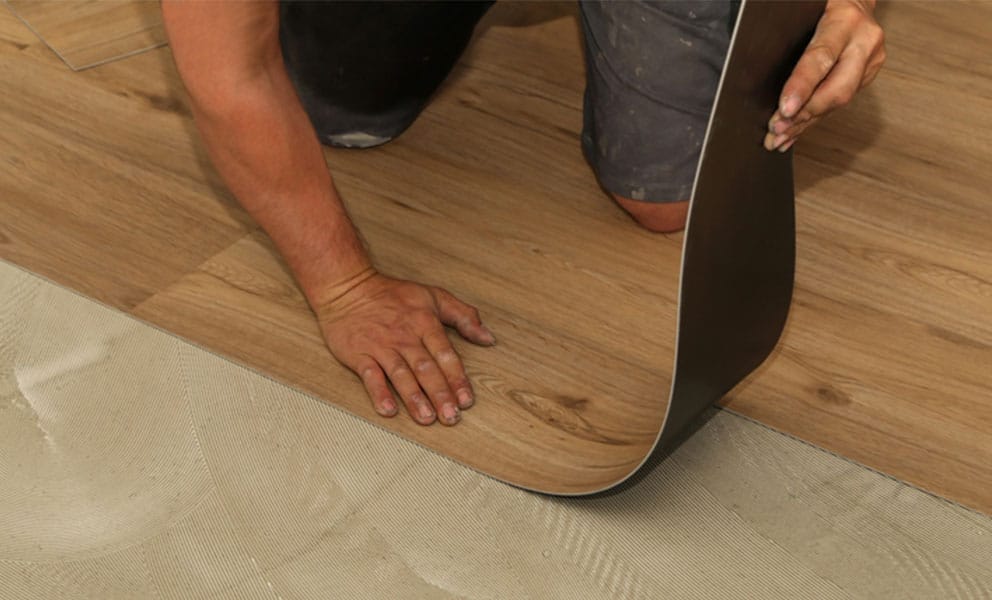Menu

Others will look for an alternative, such as installation without removal. So, can you put vinyl flooring over tile? Read on as we discuss the benefits of doing so and whether it’s possible.
Tiles have been used in the home for many years, with a particular boom of popularity in the Victorian era. However, there are many reasons why some homeowners want to update their floors, including...
Whilst the tiles themselves can be wiped over, the grout between the tiles is often a challenging point to clean. Unfortunately, if your tiles are inadequately sealed, moisture can soak deep within the grout, allowing mould to grow.
Tiles are a traditional staple of the bathroom. But for modern homes, they can often be outdated and limited in terms of design options.
Whilst tiles are usually sturdy, a heavy object only has to drop on them to make a crack or chip. Over time, these can become unsightly and allow dirt to gather.
Tiles don’t absorb moisture, so any spilt water can sit on its hard surface. This can make the surface very slippery and put you at a higher risk of accidents.
There’s nothing worse than coming out of a warm shower onto icy cold tiles. Generally speaking, tiles are not the best type of flooring for retaining heat, so homeowners often need to look for another option.
If you’ve decided to replace your tiled flooring, you might be wondering if vinyl is the best option for your floors. Let’s take a look at some of the benefits that come with vinyl flooring…
Luxury vinyl planks and tiles are very durable and can last between 10 – 20 years. This high-quality vinyl features multiple layers for maximum durability, along with a top layer to protect against scratches and tears. Plus, at Igloo Surfaces, we offer a 10-year guarantee for extra peace of mind.
Whilst tiles have limited design options, vinyl features a specific design layer, unlocking unlimited design possibilities. Vinyl flooring is a perfect choice if you’re looking for slate or wood effect flooring on a budget.
On that note, vinyl flooring is also an incredibly inexpensive choice for revamping your floors – without scrimping on style or quality.
Vinyl is really easy to install, with self-adhesive and no-adhesive options available. Our Simplex range features a floating tongue and groove click system, where interlocking planks or tiles ‘click’ together, requiring no adhesive at all.
Vinyl flooring is completely waterproof, making it perfect for use in bathrooms and kitchens, where wet floors are common. Whilst moisture can soak into the grout between tiles, causing mould and mildew, that’s not an issue for vinyl flooring – particularly for floating vinyl flooring, which can even handle high moisture subflooring.
So, can you put vinyl flooring over tile? Put simply, the answer is yes. However, there are some factors you’ll need to consider beforehand.
First, you’ll need to check how much height the vinyl will add to your current flooring. If it adds too much height, it could get in the way of opening doors, cupboards or cabinets in the room. If this is the case, you should have the tiles removed before attempting to install the vinyl.
For a successful installation, the tiled floor needs to have an even surface. So, your next step should be to check the tiles for any cracks or spaces. Before the vinyl is installed, these will need to be filled in. If there are a lot of large gaps, seams or cracks, flooring underlay should be added beneath the vinyl to even the surface.
You should also check the depth of the grout lines, as if they are not even with the tile floor, they may become noticeable beneath the vinyl. They should be patched over with a grout mix before the vinyl is applied.
Choosing a high-quality, thick luxury vinyl plank or vinyl tile is usually the best choice for covering tiles, as the additional thickness can prevent the vinyl from sinking into the grout lines.
Not only can you put vinyl flooring over tile, but you absolutely should. As well as the benefits above, there are many benefits to covering tile with vinyl.
Removing tiles can be a costly, time-consuming and messy process. On average, removing ceramic tile flooring in a standard-size room will set you back about £212, and that’s before any costs of preparing the subflooring once the tiles are up. By simply covering the tiles with vinyl flooring, you can get the look you want at a fraction of the cost.
Floating vinyl flooring offers many benefits for covering tiled floors. By choosing this type of vinyl flooring over the adhesive types, you’ll eliminate the costly and time-consuming process of applying a skim coat to the tiles, as well as applying the adhesive. You’ll also protect the original tiles from the damage adhesive could cause to its surfaces. Floating vinyl flooring is also easy to remove, so you can change styles or return to your tile floor in the future.
Whether you’re looking for copper slate floors in your bathroom or vintage oak in your kitchen, you’ll find the perfect vinyl flooring to cover tiles in our collection. Our Simplex vinyl flooring range features a tongue and groove system for easy installation. No adhesive, no mess, no hassle.
Plus, there’s a 10-year guarantee, so you can rest assured your vinyl flooring will last for many years to come. If you have any other questions about our vinyl flooring, get in touch and our expert team will be on hand to advise you.